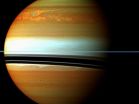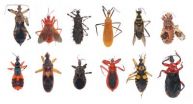(Press-News.org) NASA's Cassini spacecraft has tracked the aftermath of a rare massive storm on Saturn. Data reveal record-setting disturbances in the planet's upper atmosphere long after the visible signs of the storm abated, in addition to an indication the storm was more forceful than scientists previously thought.
Data from Cassini's composite infrared spectrometer (CIRS) instrument revealed the storm's powerful discharge sent the temperature in Saturn's stratosphere soaring 150 degrees Fahrenheit (83 kelvins) above normal. At the same time, researchers at NASA's Goddard Space Flight Center in Greenbelt, Md., detected a huge increase in the amount of ethylene gas, the origin of which is a mystery. Ethylene, an odorless, colorless gas, isn't typically observed on Saturn. On Earth, it is created by natural and man-made sources.
Goddard scientists describe the unprecedented belch of energy in a paper to be published in the Nov. 20 issue of the Astrophysical Journal.
"This temperature spike is so extreme it's almost unbelievable, especially in this part of Saturn's atmosphere, which typically is very stable," said Brigette Hesman, the study's lead author and a University of Maryland scientist who works at Goddard. "To get a temperature change of the same scale on Earth, you'd be going from the depths of winter in Fairbanks, Alaska, to the height of summer in the Mojave Desert."
First detected by Cassini in Saturn's northern hemisphere on Dec. 5, 2010, the storm grew so large that an equivalent storm on Earth would blanket most of North America from north to south and wrap around our planet many times. This type of giant disturbance on Saturn typically occurs every 30 Earth years, or once every Saturn year.
Not only was this the first storm of its kind to be studied by a spacecraft in orbit around the planet, but it was the first to be observed at thermal infrared wavelengths. Infrared data from CIRS allowed scientists to take the temperature of Saturn's atmosphere and to track phenomena that are invisible to the naked eye.
Temperature measurements by CIRS, first published in May 2011, revealed two unusual beacons of warmer-than-normal air shining brightly in the stratosphere. These indicated a massive release of energy into the atmosphere. After the visible signs of the storm started to fade, CIRS data revealed the two beacons had merged. The temperature of this combined air mass shot up to more than minus 64 degrees Fahrenheit (above 220 kelvins).
According to Hesman, the huge spike of ethylene generated at the same time peaked with 100 times more ethylene than scientists thought possible for Saturn. Goddard scientists confirmed the release of the gas using the Celeste spectrometer mounted on the McMath-Pierce Solar Telescope on Kitt Peak in Arizona.
The team still is exploring the origin of the ethylene, but has ruled out a large reservoir deep in the atmosphere.
"We've really never been able to see ethylene on Saturn before, so this was a complete surprise," said Goddard's Michael Flasar, the CIRS team lead.
A complementary paper led by Cassini team associate Leigh Fletcher of Oxford University, England, describes how the two stratospheric beacons merged to become the largest and hottest stratospheric vortex ever detected in our solar system. Initially, it was larger than Jupiter's Great Red Spot.
Their paper in the journal Icarus, which combines CIRS data with additional infrared images from other Earth-based telescopes, including NASA's Infrared Telescope Facility at Mauna Kea, Hawaii, also reports a powerful collar of clockwise winds -- encompassing a bizarre soup of gases -- around the vortex.
"These studies will give us new insight into some of the photochemical processes at work in the stratospheres of Saturn, other giants in our solar system, and beyond," said Scott Edgington, Cassini deputy project scientist at NASA's Jet Propulsion Laboratory (JPL) in Pasadena, Calif.
INFORMATION:
The Cassini-Huygens mission is a cooperative project of NASA, the European Space Agency, and the Italian Space Agency. The mission is managed by JPL for NASA's Science Mission Directorate in Washington. Hesman's work was funded in part by NASA's Planetary Astronomy Program in Washington. The CIRS instrument and Celeste spectrometer were built at Goddard.
NASA spacecraft sees huge burp at Saturn after large storm
2012-10-26
ELSE PRESS RELEASES FROM THIS DATE:
A clearer picture of how assassin bugs evolved
2012-10-26
RIVERSIDE, Calif. — Assassin bugs, so named because these insects lie in ambush for prey that they attack with speed and precision, are found all over the world. Nearly 140 species of these bugs are blood-sucking; because they can bite humans around the mouth, they are also called kissing bugs. All kissing bugs can spread Chagas disease, a neglected tropical disease that imposes an economic burden on society.
Surprising, then, that scientists' understanding of the evolutionary history of assassin bugs is riddled with difficulty. The data are incomplete. Fossils, which ...
High-risk carotid artery plaque formation is increased in older COPD patients
2012-10-26
Older patients with chronic obstructive pulmonary disease (COPD) are at increased risk for carotid artery plaque formation and for the presence of vulnerable plaques with a lipid core, according to a new study from researchers in the Netherlands.
"We know that COPD is a risk factor for ischemic stroke, and that certain components of carotid artery plaques such as intraplaque hemorrhage and lipid core increase the risk of ischemic events, but plaque composition in patients with COPD has not been examined," said researcher Bruno H.C. Stricker, MD, PhD, professor of pharmaco-epidemiology ...
Integrated diabetes management program provides rapid improvements in patient care
2012-10-26
Ottawa, October 26, 2012 - In Canada alone, almost 2 million people are known to be living with diabetes. And around a million more have the disease but are not aware of that fact, and have not been given the tools they need to control their blood sugar and safeguard their health. The Heart Institute will be presenting the results of an innovative pilot program on October 29, at the Canadian Cardiovascular Congress in Toronto, Canada.
Diabetic patients have a much greater risk of dangerous cardiovascular events, including recurrent heart attacks and development of heart ...
Tips to Help Establish Financial Security After Divorce
2012-10-26
A divorce marks more than just the end of a relationship; it also represents the end of a financial partnership. As a result, it is important to take a step back from the emotional side of the divorce and review the financial side both during and after the divorce proceeding.
Before a divorce is finalized, it is wise to attempt to develop a post-divorce budget. This will help you to determine what assets you need when determining marital property division in the divorce.
After the divorce is complete, take a moment to look over your new expenses and income. Review ...
Franchisee Lawsuit Against Cold Stone Creamery Subject to Arbitration
2012-10-26
A group of Cold Stone Creamery franchisees is suing parent company Cold Stone Creamery Inc. over the failure of the franchisor to disclose information about marketing and gift cards. The franchisee-franchisor suit regarding an alleged lack of transparency was filed in a Florida court.
The National Independent Association of Cold Stone Creamery Franchisees filed suit against Cold Stone Creamery earlier this year asking Cold Stone to disclose the amount of money in a flexible marketing program and the unspent amount in the ice cream chain's gift card program. The NIACCF ...
Non-Disclosure and Non-Compete Agreements Important Tools for Businesses
2012-10-26
Proprietary information is the life blood of businesses and it is as important as ever in today's business world. Businesses can use tools like non-disclosure forms to protect trade secrets from third parties, and tools like non-compete agreements to help ensure that former employees who learned their skills and knowledge from the business do not use confidential business information to benefit competitors.
One way a business can protect its unique information from being used elsewhere is a non-disclosure agreement. A non-disclosure or confidentiality agreement requires ...
Austin Foreclosure Rates Show Signs of Improvement
2012-10-26
After a long stretch of elevated foreclosure rates in Texas and around the country, recent months have brought some signs of stabilization in the real estate market. In July 2012, foreclosure rates in Austin dropped slightly in both month-to-month and year-over-year measurements. According to consumer analytics firm CoreLogic Inc., 1.05 percent of Austin homes were in some stage of foreclosure in July 2012, compared with 1.07 percent the previous month and 1.08 percent in July 2011.
Mortgage delinquencies also show signs of decline, with 2.88 percent of Austin mortgages ...
Risk of Defects Increases as Contractors Expand Into New Markets
2012-10-26
In the last few years the tough economy has caused many businesses to change how they work. In some cases, these changes can lead to innovation in the marketplace; in others it can lead to an increased risk of potential injuries and faulty products.
Unfortunately, some contractors are falling into the latter category. Many contractors are attempting to stay afloat financially by taking on jobs in new markets. Professionals within the construction industry state that contractors are often tempted to expand their market by going one of three different directions:
-Expanding ...
U.S. Appeals Court Says Warrantless Police Search of Cellphones Is Legal
2012-10-26
The data police can and cannot obtain from a cellphone or GPS tracking device without a warrant has been a frequent subject of legal dispute in recent years. The U.S. 7th Circuit Court of Appeals recently weighed in on the subject, ruling that police can look at a cellphone without a warrant to obtain the cellphone's number. Gaining the phone's number allows police to track the cellphone's call history and location by contacting the cellphone's carrier.
The issue arose from a case involving an alleged drug crime. Police found a cellphone on the suspect, Alberto Santana-Cabrera, ...
Chicago Cracks Down on Retailers Selling Synthetic Drugs
2012-10-26
Chicago was the first large city in the country to punish retailers that sell synthetic drugs that mimic the effects of marijuana and other illegal drugs. Commonly disguised as bath salts, incense or potpourri, these synthetic drugs are often changed chemically to make them legal but still provide users with intoxicating effects. However, the side effects of the drug can be severe; they can cause hallucinations, seizures, paranoid behavior and high blood pressure. In some cases they can cause violent episodes or cause users to go, "Out of their minds," according ...

